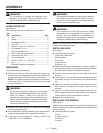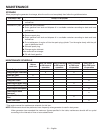
17 — English
MAINTENANCE
WARNING:
When servicing, use only identical RIDGID
replacement parts. Use of any other parts may
create a hazard or cause product damage.
Only the parts shown on the parts list are intended to be
repaired or replaced by the customer. All other parts should
be replaced at an authorized service center.
GENERAL MAINTENANCE
Keep the generator in a clean and dry environment where it
is not exposed to dust, dirt, moisture, or corrosive vapors.
Do not allow the cooling air slots in the generator to become
clogged with foreign material such as leaves, etc.
Do not use a garden hose to clean the generator. Water
entering the fuel system or other internal parts of the unit can
cause problems that will decrease the life of the generator.
To clean the unit:
Use a soft bristle brush and/or vacuum cleaner to loosen
and remove dirt and debris.
Clean air vents with low pressure air that does not exceed
25 psi.
Wipe the exterior surfaces of the generator with a damp
cloth.
CHANGING FUSE
See Figure 21.
Remove screw from side cover.
Lift up and remove side cover.
Unscrew the fuse holder to reveal the fuse and spring.
Insert new fuse into hole and retighten fuse holder se-
curely.
NOTE: If spring came out of fuse holder when it was
opened, it should also be replaced inside the fuse holder
before securing.
Reinstall side cover.
Reinstall screw and tighten securely.
CHECKING/CLEANING AIR FILTER
See Figure 22.
For proper performance and long life, keep air filter clean.
Release latches on left side of air filter cover. Remove
cover and set aside.
Remove the filter element.
If the filter element is dirty, clean with warm, soapy water.
Rinse and let dry.
Apply a light coat of engine lubricant to the element, then
squeeze it out.
Replace the element in the air filter unit.
Replace the air filter cover and latch to secure.
NOTE: Do not run the generator without the air filter. Rapid
engine wear will result.
CHANGING ENGINE LUBRICANT
See Figure 23.
Remove the oil cap/dipstick.
Place a container underneath the oil drainage bolt to
collect used lubricant as it drains.
Unscrew the oil drainage bolt and remove.
Allow lubricant to drain completely.
Reinstall the oil drainage bolt and tighten securely.
Refill with lubricant following the instructions in the
Checking/Adding Lubricant section.
Reinstall the oil cap/dipstick.
NOTE: Used lubricant should be disposed of at an ap-
proved disposal site. See your local oil retailer for more
information.
SPARK PLUG MAINTENANCE
See Figure 24.
The spark plug must be properly gapped and free of deposits
in order to ensure proper engine operation. To check:
Remove the spark plug cap.
Clean any dirt from around base of spark plug.
Remove spark plug using wrench (not included).
Inspect spark plug for damage, and clean with a wire
brush before reinstalling. If insulator is cracked or
chipped, spark plug should be replaced.
NOTE: If replacing, use the following recommended
spark plugs or equivalent: NGK BPR4ES.
Measure plug gap. The correct gap is 0.028−0.031 in.
(0.7-0.8 mm). To widen gap, if necessary, carefully bend
the ground (top) electrode. To lessen gap, gently tap
ground electrode on a hard surface.
Seat spark plug in position; thread in by hand to prevent
cross-threading.
Tighten with wrench to compress washer. If spark plug
is new, use 1/2 turn to compress washer appropriate
amount. If reusing old spark plug, use 1/8 to 1/4 turn for
proper washer compression.
NOTE: An improperly tightened spark plug will become
very hot and could damage the engine.


















